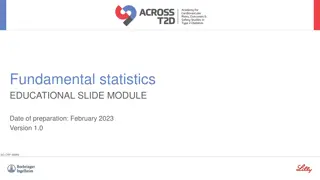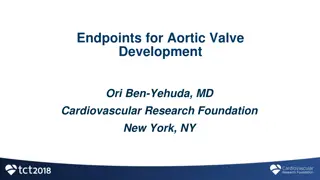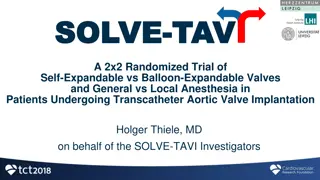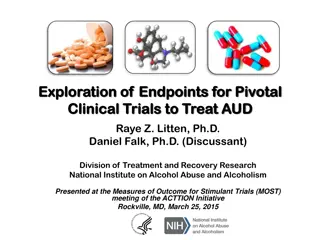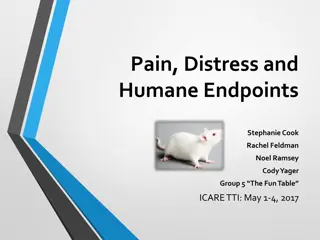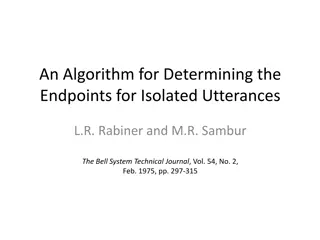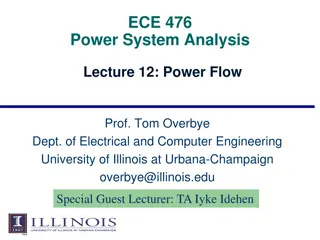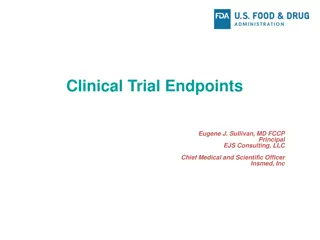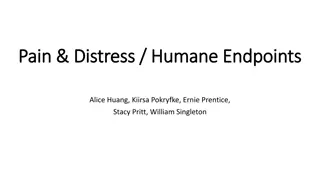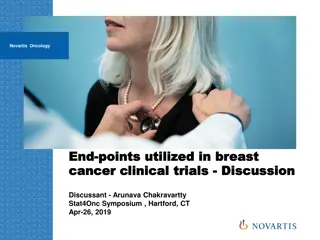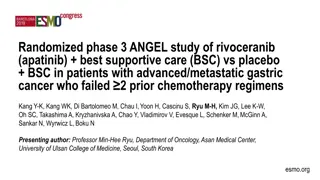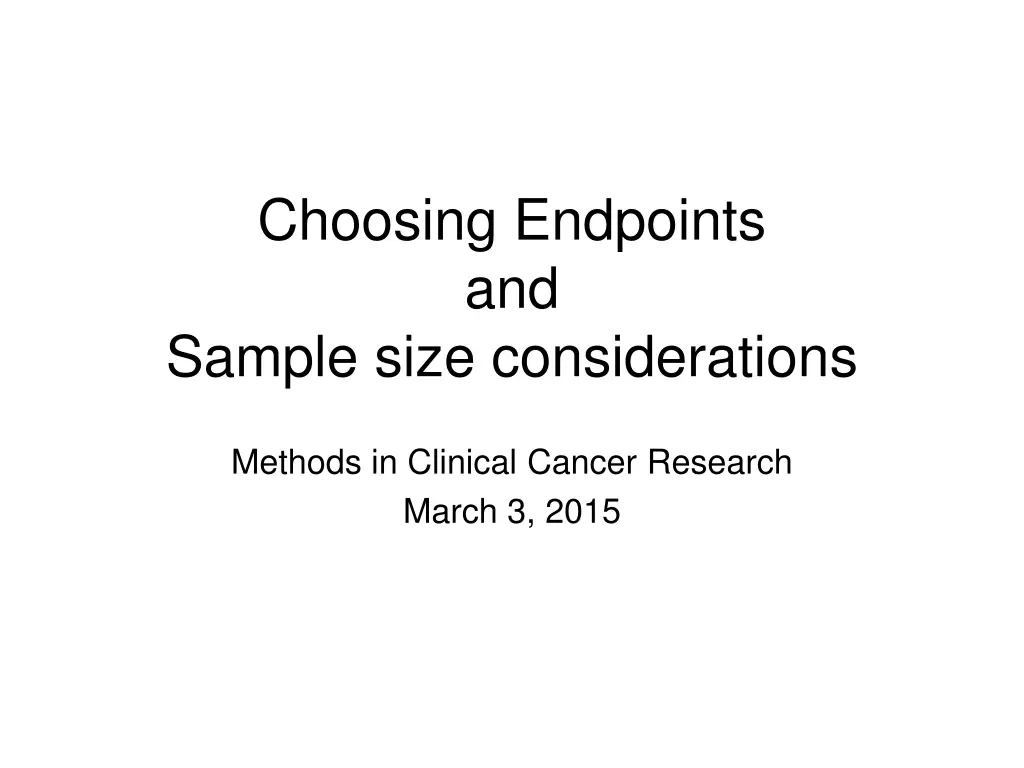
Methods in Clinical Cancer Research: Choosing Endpoints and Sample Size Considerations
Understanding the importance of sample size and power in clinical cancer research is crucial for drawing reliable conclusions. This article discusses the implications of choosing the right sample size, defining parameters, and reviewing statistical power to ensure the effectiveness of treatments. Learn about common outcome settings and the impact of sample size on study outcomes.
Download Presentation

Please find below an Image/Link to download the presentation.
The content on the website is provided AS IS for your information and personal use only. It may not be sold, licensed, or shared on other websites without obtaining consent from the author. If you encounter any issues during the download, it is possible that the publisher has removed the file from their server.
You are allowed to download the files provided on this website for personal or commercial use, subject to the condition that they are used lawfully. All files are the property of their respective owners.
The content on the website is provided AS IS for your information and personal use only. It may not be sold, licensed, or shared on other websites without obtaining consent from the author.
E N D
Presentation Transcript
Choosing Endpoints and Sample size considerations Methods in Clinical Cancer Research March 3, 2015
Sample Size and Power The most common reason statisticians get contacted Sample size is contingent on design, analysis plan, and outcome With the wrong sample size, you will either Not be able to make conclusions because the study is underpowered Waste time and money because your study is larger than it needed to be to answer the question of interest And, with wrong sample size, you might have problems interpreting your result: Did I not find a significant result because the treatment does not work, or because my sample size is too small? Did the treatment REALLY work, or is the effect I saw too small to warrant further consideration of this treatment? This is an issue of CLINICAL versus STATISTICAL significance
Sample Size and Power Sample size ALWAYS requires the investigator to make some assumptions How much better do you expect the experimental therapy group to perform than the standard therapy groups? How much variability do we expect in measurements? What would be a clinically relevant improvement? The statistician CANNOT tell you what these numbers should be (unless you provide data) It is the responsibility of the clinical investigator to define these parameters
Sample Size and Power Review of power o Power = The probability of concluding that the new treatment is effective if it truly is effective o Type I error = The probability of concluding that the new treatment is effective if it truly is NOT effective o (Type I error = alpha level of the test) o (Type II error = 1 power) When your study is too small, it is hard to conclude that your treatment is effective
Three common settings Binary outcome: e.g., response vs. no response, disease vs. no disease Continuous outcome: e.g., number of units of blood transfused, CD4 cell counts Time-to-event outcome: e.g., time to progression, time to death.
Most to least powerful Continuous Time-to-event Binary/categorical Example: mouse study Metastases yes vs. no Volume or number of metastatic nodules
Continuous outcomes Easiest to discuss Sample size depends on : difference under the null hypothesis : type 1 error type 2 error : standard deviation r: ratio of number of subjects in the two groups (usually r = 1)
Continuous Outcomes We usually find sample size OR find power OR find But for Phase III cancer trials, most typical to solve for N.
Example: sample size in EACA study in spine surgery patients* The primary goal of this study is to determine whether epsilon aminocaproic acid (EACA) is an effective strategy to reduce the morbidity and costs associated with allogeneic blood transfusion in adult patients undergoing spine surgery. (Berenholtz) Comparative study with EACA arm and placebo arm. Primary endpoint: number of allogeneic blood units transfused per patient through day 8 post-operation. Average number of units transfused without EACA is expected to be 7 Investigators would be interested in regularly using EACA if it could reduce the number of units transfused by 30% (to 5 units or less). * Berenholtz et al. Spine, 2009 Sept. 1.
Example: sample size in EACA study in spine surgery patients H0: 1 2 = 0 H1: 1 2 0 We want to know what sample size we need to have large power and small type I error. If the treatment DOES work, then we want to have a high probability of concluding that H1is true. If the treatment DOES NOT work, then we want a low probability of concluding that H1is true.
Two-sample t-test approach Assume that the standard deviation of units transfused is 4. Assume that difference we are interested in detecting is 1 2 = 2. Assume that N is large enough for Central Limit Theorem to kick in . Choose two-sided alpha of 0.05
Two-sample t-test approach 1 reject H | H true) | H true) Power = - b =P( 0 a =P( |t|>Z a a X s ( X + 1 2 = H true a P Z a 2 1 1 2 ) n n 1 2 H true a P Z a ( + 2 1 1 2 ) n n 1 2
Two-sample t-test approach For testing the difference in two means, with equal allocation to each arm: With UNequal allocation to each arm, where n2 = rn1 + 2 2 ( ) Z Z = n 2 1 + 2 2 ( ) Z Z + 1 r = n 2 1 r
Sample size = 30,Power = 26% Sampling distn under H1: 1 - 2 = 0 Sampling distn under H1: 1 - 2 = 2 0.25 0.20 Vertical line defines rejection region 0.15 Density 0.10 0.05 0.00 -4 -2 0 1 - 2 2 4 6 8
Sample size = 60,Power = 48% Sampling distn under H1: 1 - 2 = 0 Sampling distn under H1: 1 - 2 = 2 0.4 0.3 Vertical line defines rejection region Density 0.2 0.1 0.0 -4 -2 0 1 - 2 2 4 6 8
Sample size = 120,Power = 78% Sampling distn under H1: 1 - 2 = 0 Sampling distn under H1: 1 - 2 = 2 0.5 0.4 Vertical line defines rejection region Density 0.3 0.2 0.1 0.0 -4 -2 0 2 4 6 8 1 - 2
Sample size = 240, Power = 97% Sampling distn under H1: 1 - 2 = 0 Sampling distn under H1: 1 - 2 = 2 0.8 0.6 Vertical line defines rejection region Density 0.4 0.2 0.0 -4 -2 0 2 4 6 8 1 - 2
Sample size = 400, Power > 99% Sampling distn under H1: 1 - 2 = 0 Sampling distn under H1: 1 - 2 = 2 1.0 0.8 Vertical line defines rejection region 0.6 Density 0.4 0.2 0.0 -4 -2 0 2 4 6 8 1 - 2
Likelihood Approach Not as common, but very logical Resulting sample size equation is the same, but the paradigm is different. Create likelihood ratio comparing likelihood assuming different means vs. common mean: 2 2 exp( ) x 2 N N 2 1 exp( ) x 1 2 2 2 j 1 2 i L X ( | ) 2 = = 1 1 i j + 2 N N 2 1 exp( ) xi 1 2 L X ( | ) 2 2 = 1 i + N N 1 2 2 1 exp ( ) x 2 i 2 = 1 i = LR N N 1 2 + + 2 2 1 1 exp ( ) ( ) x x 2 2 1 2 i j 2 2 = = 1 1 i j
Other outcomes Binary: use of exact tests often necessary when study will be small more complex equations than continuous Why? Because mean and variance both depend on p Exact tests are often appropriate If using continuity correction with 2 test, then no closed form solution Time-to-event similar to continuous parametric vs. non-parametric assumptions can be harder to achieve for parametric
Single Arm, response rate Ho: p= 0.20 Ha: p = 0.40 One-sided alpha 0.05
Time to event endpoints Power depends on number of events For the same number of patients, accrual time, and expected hazard ratio, the power may be very different. The number of expected events at time of analysis determines power.
Example: Median PFS 4 months vs. 8 months HR = 0.5 12 month accrual, 12 month follow-up Two-sided alpha = 0.05 Power = 94%
Example: Median PFS 12 months vs. 24 months HR = 0.5 12 month accrual, 12 month follow-up Two-sided alpha = 0.05 Power = 77%
Choosing endpoints Mostly a phase II question Common predicament PFS vs. response OS vs. PFS Binary PFS vs. time to event PFS
Choosing type I and II errors Phase III: Type I: One-sided 0.025 Two-sided 0.05 Type II: 20% (i.e. power of 80%) Phase II More balanced Common to have 10% of each Common to see 1-sided tests with single arm studies especially
Other issues in comparative trials Unbalanced design why? might help accrual; might have more interest in new treatment; one treatment may be very expensive as ratio of allocation deviates from 1, the overall sample size increases (or power decreases) Accrual rate in time-to-event studies Length of follow-up per person affects power Need to account for accrual rate and length of study
Equivalence and Non-inferiority trials When using frequentist approach, usually switch H0 and Ha Non-inferiority trial Superiority trial = : : 0 0 H Ha = : : 0 0 H Ha 0 0
Equivalence and Non-inferiority trials Slightly more complex To calculate power, usually define: H0: > d Ha: < d Usually one-sided Choosing and now a little trickier: need to think about what the consequences of Type I and II errors will be. Calculation for sample size is the same, but usually want small . Sample size is usually much bigger for equivalence trials than for standard comparative trials.
Equivalence and Non-inferiority trials Confidence intervals more natural to some Want CI for difference to exclude tolerance level E.g. 95% CI = (-0.2,1.3) and would be willing to declare equivalent if = 2 Problems with CIs: Hard-fast cutoffs (same problem as HTs with fixed ) Ends of CI don t mean the same as the middle of CI Likelihood approach probably best (still have hard-fast rule, though).
Non-inferiority example Recent PRC study. Sorafenib vs. Sorafenib + A in hepatocellular cancer Primary objective: demonstrate that safety of the combination is no worse than sorafenib alone.
Example Toxicity rate of Sorafenib alone: assumed to be 40%. A toxicity rate of no more than 50% would be considered non-inferior . Hypothesis test for combination (c) and sorafenib alone (s) H0: pc ps 0.10 H1: pc ps < 0.10
Calculations Must specify rate in each group and delta. Note that the difference in rates may not need to equal delta. Example: Trt A vs. Trt B Equivalent safety profiles might be implied by delta of 0.10 (i.e. no more than 10% worse). But, you may expect that Trt B (novel) actually has a better safety profile.
Non-inferiority sample sizes Example 1 New trt has lower toxicity 5% 80% 40% Example 2 New trt has equal toxicity 5% 80% 40% Example 3 New trt has worse toxicity 5% 80% 40% Alpha Power Toxicity rate, control group Toxicity rate, novel trt group Delta 30% 40% 45% 10% 10% 10% Sample size required (total) 140 594* 2414 *If there is truly no difference between the standard and experimental treatment, then 594 patients are required to be 80% sure that the upper limit of a one-sided 95% confidence interval (or equivalently a 90% two-sided confidence interval) will exclude a difference in favor of the standard group of more than 10%.
Other considerations: cluster randomization Example: Prayer-based intervention in women with breast cancer To implement, identified churches in S.E. Baltimore Women within churches are in same group therapy sessions Consequence: women from same churches has correlated outcomes Group dynamic will affect outcome Likely that, in general, women within churches are more similar (spiritually and otherwise) than those from different churches Power and sample size? Lack of independence need larger sample size to detect same effect Straightforward calculations with correction for correlation Hardest part: getting good prior estimate of correlation!
Other Considerations: Non-adherence Example: side effects of treatment are unpleasant enough to encourage drop-out or non-adherence Effect? Need to increase sample size to detect same difference Especially common in time-to-event studies when we need to follow individuals for a long time to see event. Adjusted sample size equations available (instead of just increasing N by some percentage) Cross-over: an adherence problem but can be exacerbated. Example: vitamin D studies
Glossed over. Interim analyses These will increase your sample size but usually not by much. Goal: maintain the same OVERALL type I and II errors. More looks, more room for error. But, asymmetric looks are a little different .
Futility only stopping At stage 1, you can only declare fail to reject the null At stage 2, you can fail to reject or reject the null. Two opportunities for a Type II error One opportunity for a Type I error Ignoring interim look in planning Increases type II error; decreases power Decreases type I error. Why? Two hurdles to reject the null. Non-binding stopping boundary.
Practical Considerations We don t always have the luxury of finding N Often, N fixed by feasibility We can then vary power or clinical effect size But sometimes, even that is difficult. We don t always have good guesses for all of the parameters we need to know
Not always so easy More complex designs require more complex calculations Usually also require more assumptions Examples: Longitudinal studies Cross-over studies Correlation of outcomes Often, simulations are required to get a sample size estimate.
(1) Odds ratio between cases and controls for a one standard deviation change in marker (2) (3) (4) (5) Power for X1 as simulated Power for X1 replaced with median from respective quintile Matching SD(a)/SD(marker) 0.25 1:1 1:2 1:1 1:2 1:1 1:2 0.52 0.70 0.50 0.59 0.29 0.38 0.48 0.65 0.44 0.53 0.26 0.36 1.12 0.5 1 0.25 1:1 1:2 1:1 1:2 1:1 1:2 0.76 0.88 0.70 0.81 0.50 0.64 controls) 0.72 0.87 0.66 0.74 0.44 0.56 Matching 1.16 0.5 (1) (2) (3) (4) (5) 1 Odds ratio between cases and controls for a one standard deviation change in marker (in units of standard deviations of the controls) Power for X1 as simulated Power for X1 replaced with median from respective quintile SD(a)/SD(marker in 0.25 1:1 1:2 1:1 1:2 1:1 1:2 0.94 0.98 0.92 0.97 0.79 0.92 0.92 0.97 0.89 0.95 0.71 0.89 1.22 0.5 0.25 1:1 1:2 1:1 1:2 1:1 1:2 0.55 0.75 0.51 0.65 0.32 0.50 0.54 0.70 0.50 0.59 0.31 0.43 1.16 1 0.5 0.25 1:1 1:2 1:1 1:2 1:1 1:2 > 0.99 >0.99 0.99 >0.99 0.95 0.99 0.98 >0.99 0.98 >0.99 0.91 0.97 1.28 1 0.5 0.25 1:1 1:2 1:1 1:2 1:1 1:2 0.77 0.88 0.75 0.87 0.64 0.78 0.73 0.84 0.73 0.82 0.57 0.72 1.22 1 0.5 1 0.25 1:1 1:2 1:1 1:2 1:1 1:2 0.92 0.98 0.89 0.97 0.84 0.94 0.91 0.97 0.88 0.95 0.82 0.88 1.28 0.5 1
Helpful Hint: Use computer! At this day and age, do NOT include sample size formula in a proposal or protocol. For common situations, software is available Good software available for purchase Stata (binomial and continuous outcomes) NQuery PASS Power and Precision Etc .. FREE STUFF ALSO WORKS! Cedars Sinai software https://risccweb.csmc.edu/biostats/ Cancer Research and Biostatistics (non-profit, related to SWOG) http://stattools.crab.org/


